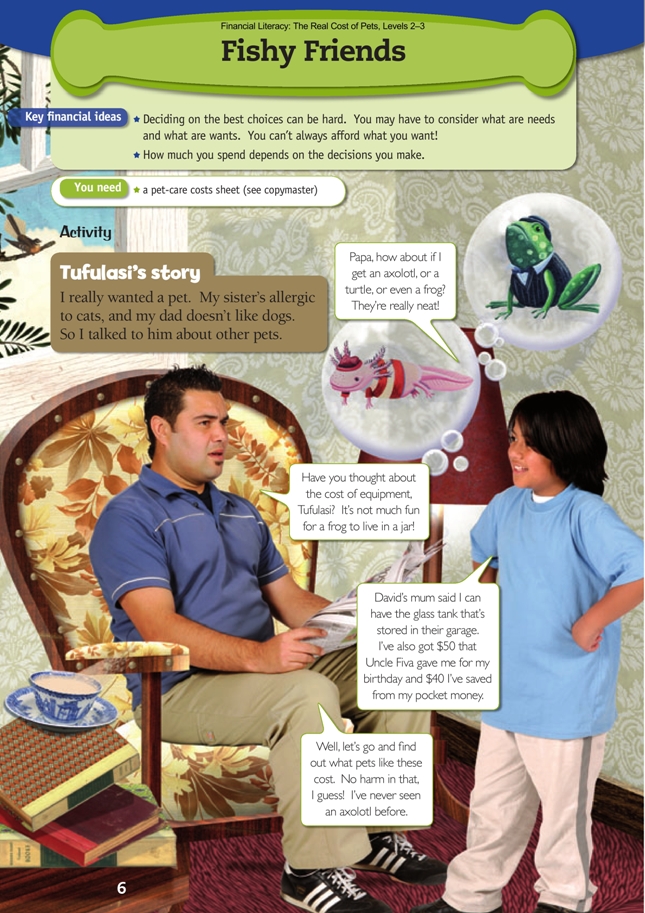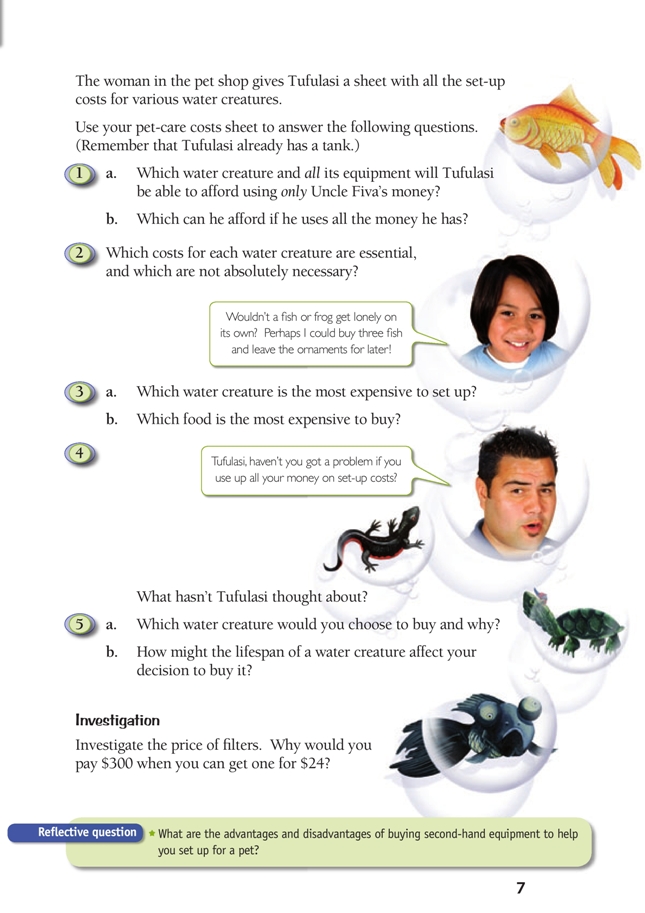This is a level 2 number and level 3 algebra activity from the Figure It Out series. It relates to Stage 5 of the Number Framework.
A PDF of the student activity is included.
Click on the image to enlarge it. Click again to close. Download PDF (1808 KB)
use additive strategies to add numbers
compare food prices
Number Framework Links
Students at stage 5 could work independently (after initial teacher interaction), using a calculator or other materials such as money. Students at stage 6 should be able to use more advanced numeracy strategies to solve the mathematical problems in this activity independently. (See the table of NDP material on page 4.)
Pet-Care costs sheet (see Copymaster)
Financial understanding
This activity emphasises that you can’t always afford what you want. Tufulasi has already accepted that he can’t have a cat or a dog, but he is now learning how to distinguish between the items that are essential for his possible pet and those he would like to have. This activity will help students understand that people’s
preferences or priorities impact on their financial decisions.
Tufulasi shows that he is able to be flexible and deal with change, which is the enterprising attribute shown by people who are able to relate well to each other. The students are generating, identifying, and assessing opportunities as they investigate the affordability of buying a water creature.
You may need to discuss with the students what is meant by set-up costs and lifespan.
For question 3a, the students could investigate how they could go about finding the equipment to set up an aquarium for free or very cheaply.
Mathematics and statistics
For question 5b, you need to take care that the lifespans are “friendly” numbers for students at stage 5, such as times 2, 5, or 10. You could develop this concept using materials, for example, sharing money between groups to represent the number of years the animal could be expected to live. The students could also do this with strips
of paper, by having the total money costs listed on a strip and then folding the strip to represent the number of years.
Investigation
Financial understanding
This investigation raises the issue of the relative merits of buying or using cheaper equipment compared with more expensive equipment. Encourage the students to share any experiences they or their families may have had (but take care that value judgments do not become dominant). Discuss why there are times when people decide on cheaper options even though they know that the equipment may not last very long or be as cost-effective. This discussion may also bring up issues around branding (for example, paying more for a known or popular brand or buying New Zealand-made items).
Further investigations: mathematics and statistics; social sciences
The students could:
• undertake a statistical investigation by comparing the lifespan of water creatures, using a mobile, pictograph, timeline, and so on. (Have the students include tadpoles and turtles to demonstrate how vast the difference is.)
• research and suggest items that could be recycled or reused to set up an aquarium.
• research materials that can’t be used (for example, copper will poison water creatures).
• research the costs and the health and safety aspects of making an outdoor goldfish pond.
• research which water creatures have to be kept apart from others, for example, carnivorous fish, and the financial impact of this for someone who wants to keep a variety of water creatures.
• research how long water creatures have been kept as pets and what has contributed to this length of time (for example, electricity needs being seen in earlier days as luxury items).
• research what the purpose is of large public aquariums that people visit. The research could be presented in a range of tables and graphs, and the students could make statements or decisions based on the statistical information gathered.
Social Sciences Links
Achievement objective:
• Understand how people make choices to meet their needs and wants (Social Studies, level 2)
Discuss with the students what questions and information Tufulasi needs in order to make choices about what sort of pet he will buy.
Other Cross-curricular Links
Technology achievement objective:
• Brief development: Describe the nature of an intended outcome, explaining how it addresses the need or opportunity. Describe the key attributes that enable development and evaluation of an outcome (Technological Practice, level 3)
The students could:
– design a fish tank and all the things to go inside
– research and design a filtering system for a tank.
Answers to Activity
1. a. None
b. With $90, and using the tank from David’s mum, Tufulasi could buy a goldfish, with a $24 filter, food, plants, water conditioner, stress coat, sand, and $8 worth of
ornaments. If he wants a frog or a tropical fish, he will need extra money for light and
heating.
2. Answers will vary. Fake rocks and ornaments aren’t essential, plants (unless they are plastic) do help to provide oxygen, and food is a must.
3. a. Answers will vary, depending, for example, on whether you go for lower or higher tank and filter prices. A turtle may be the most
expensive, followed by an axolotl.
b. Axolotl food costs $2 less than turtle food, but it also depends on how much each type of pet eats at a time.
4. Answers will vary. Tufulasi will need money for ongoing food and possibly replacement of equipment at some stage. Power to run the filter will add to the family’s power bill, and he will need cleaning tools for cleaning the tank and filter.
5. a. Choices and reasons will vary.
b. Answers will vary. If you spend a lot of money on setting up for a creature that doesn’t live long, you will need to have spare money to replace that creature. Or if you choose a pet, such as a turtle, that lives for a long time, you may not still want it when you are older.
Investigation
Discussion will vary. The cheapest one may need replacing frequently and may not do as good a job. On the other hand, the cheapest one may be just as effective as the more expensive ones but may not look as flash.
Reflective question
Answers will vary. With second-hand equipment, you might have money left over for ongoing costs or for buying extra fish. Second-hand equipment is usually cheaper than new equipment, although you should look around for special offers too. The
second-hand equipment may last just as long as more expensive new equipment. However, the disadvantages are that second-hand equipment may have flaws that you can’t see or it may be near the end of its usefulness, and in either case, you are not covered by a warranty for repairs or replacement

